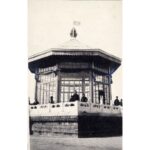Photography Bell Tower at the Temple of Heaven
A black-and-white photograph showing the Gulou Bell Tower 鼓樓 in the northeastern part of the environs of the Hall of Fasting (Zhaigong 齋宮) in the Temple of Heaven (Tiantan 天壇) complex in Beijing. The complex was built in 1420 by the Yongle Emperor (reigned 1402–1424). Here the emperors of the Ming and Qing dynasties performed the rites of heavenly worship twice a year. In the Hall of Fasting, the emperor performed purification and fasting rites before the main ritual on the day of the winter solstice, when thanks were given to heaven for the favours of the past year. The ringing of the bells in the Bell Tower announced the end of the fasting period and the beginning of the main ritual, and with it the emperor’s departure for the main venue – the Yuanqiu Altar (Yuanqiutan 圜丘壇). The last emperor to bow to heaven in the Temple of Heaven was Yuan Shikai 袁世凱 (reigned 1915–1916), who for several months tried unsuccessfully to revive the monarchy. This marked ... more
A black-and-white photograph showing the Gulou Bell Tower 鼓樓 in the northeastern part of the environs of the Hall of Fasting (Zhaigong 齋宮) in the Temple of Heaven (Tiantan 天壇) complex in Beijing. The complex was built in 1420 by the Yongle Emperor (reigned 1402–1424). Here the emperors of the Ming and Qing dynasties performed the rites of heavenly worship twice a year. In the Hall of Fasting, the emperor performed purification and fasting rites before the main ritual on the day of the winter solstice, when thanks were given to heaven for the favours of the past year. The ringing of the bells in the Bell Tower announced the end of the fasting period and the beginning of the main ritual, and with it the emperor’s departure for the main venue – the Yuanqiu Altar (Yuanqiutan 圜丘壇). The last emperor to bow to heaven in the Temple of Heaven was Yuan Shikai 袁世凱 (reigned 1915–1916), who for several months tried unsuccessfully to revive the monarchy. This marked the end of a centuries-old tradition. Today, the Temple of Heaven is on the UNESCO World Cultural Heritage List, as it is the largest religious complex in the world.
The tower was built using the traditional Chinese construction technique, the dougong 斗拱 system. The dougong technique dates back to the Ming Dynasty (1368–1644). It is characterised by the use of wooden joints or dowels, which allow the structural elements to support each other during construction. This system eliminates the need for nails and glue. Besides the dowels visible in the eaves, other features of Chinese construction in this building are the shape of the roofs and the use of colours, numbers and decorative animal figures on the roofs.
The photograph is the 190th of 449 photographs of Beijing and its surroundings in the album of Ivan Skušek Jr., purchased during his stay in Beijing (1914–1920). In the handwritten inventory of the album, the photograph is referred to as Himmels-Tempel: Glockenturm”. (DZ, MV)





































Do you have a comment or additional information about the subject?